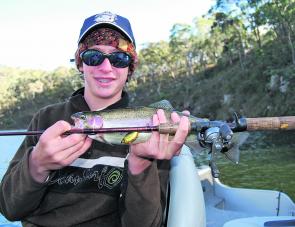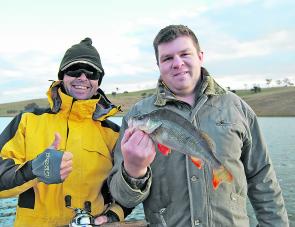It can be very chilly around these parts now, to say the least, with daily temps in single digits and at night it’s regularly below zero.
We are, however, blessed with three Northern Hemisphere species, rainbow and brown trout and English perch or redfin, all of which are right at home in the Winter cold.
However, many people traveling to the area aren’t as well prepared as the fish. They forget, or are just not used to dressing for the conditions.
Even here at home I take the cold weather for granted at times.
The 10-minute drive up to Thompsons Creek Dam from my place can provide a definite reality check. The difference in elevation is possibly 300m or 400m and the temperature difference can sometimes be 3°-4° with a wind chill factor of who knows what.
Layering is a term commonly used for Winter outdoor clothing.
It starts with a close-to-body layer (thermals, merino is a great fabric for this), followed by a mid-layer of polar fleece or a wool blend, then a windproof, waterproof shell over the top, such as Gore-Tex.
Any old socks won’t cut it, either. If you’re anything like me, once your toes get cold then that’s it, she’s all over.
Quality socks are not cheap but are well worth the coin if you ask me. Thicker is not always the answer; in fact some of the thinner socks made with good material can be better.
Bamboo is not something you would not normally associate with socks, but they do make socks out of the stuff and I would have to say they are pretty damn good.
Your noggin is where most of your body heat is lost so keep it well covered.
On extreme days I double up with a thin merino blend beanie and a thicker one over the top. Those neck and face socks are great as well.
This may all sound a bit extreme but at this time of year it’s about being comfortable. If you’re comfortable in the conditions you’re more likely to stay out. And if you stay out, your line is in the water and that’s where the fish are.
Trout can be difficult to catch at the best of times but throw spawning behaviour into the mix and things can get a little tricky.
With the creeks and rivers now out of season, the dams are our only options.
The upper reaches of lakes such as Lyell, Oberon and Ben Chifley will definitely have higher concentrations of trout.
Thompsons Creek Dam is a little different. It is a basin dam with very little in the way of run-off – water is pumped into it.
Trout in TCD are quite happy using the long gravel points and rocky headlands as congregation points.
Seeing the trout and catching them are two vastly different things.
Downsizing your tackle, staying low along the banks and the water’s edge and being there early are the keys.
Fly-fishing has the advantage of being able to deliver something very small and inconspicuous, although standing up and casting can spook fish so keep your false casting to a minimum.
Boats in skinny backwaters on Lake Lyell and Ben Chifley can put fish off, I am sure of that.
The fish may not move but getting them to bite anything is nigh on impossible.
Getting out on the bank may be an option, or you could pull the boat up and fish out the back.
Just be very quiet, turn the sounder off keep your movements to a minimum.
If you’re throwing lures, sometimes the polar opposite of small and inconspicuous can work a treat.
A bright, flashy spoon or a large minnow can be a real winner, especially if you see fish bow-waving or chasing one another close to the surface.
Large buck rainbows and browns sometimes throw caution to the wind and lash out at such offerings.
I love chasing redfin over Winter in Ben Chifley and Carcoar dams. In larger sizes and on light gear they give a good account of themselves.
Fish throwing hooks boatside can be frustrating, so take it easy and make a good net shot.
Quite a few techniques can work on these fish but paying close attention to your sounder is the key.
Make informed decisions on how you fish based on what you are seeing on the sounder.
For example, if the fish are scattered at a particular depth across a wide area then trolling at that depth will be the best approach.
If the fish are schooled and relating to a particular piece of structure, casting or jigging will be the go.
Be patient with approaches, try different lures and presentations and let the fish tell you what works best.
Reads: 1483
Sometimes throwing something a little left of centre can work a treat on pre-spawn trout, In this case it was a little lipless crankbait.

Dressed for the occasion, you could say. Ben Chifley Dam during Winter is no place for the faint-hearted or underdressed, Andrew and Dale stayed focused for long enough for this average Winter redfin.




